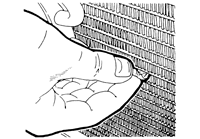Air Conditioning Inspection
System Inspection
Although the A/C system should not be serviced by the do-it-yourselfer, preventive maintenance can be practiced and A/C system inspections can be performed to help maintain the efficiency of the vehicle's A/C system. For A/C system inspection, perform the following: The easiest and often most important check for the air conditioning system consists of a visual inspection of the system components. Visually inspect the air conditioning system for refrigerant leaks, damaged compressor clutch, abnormal compressor drive belt tension and/or condition, plugged evaporator drain tube, blocked condenser fins, disconnected or broken wires, blown fuses, corroded connections and poor insulation.
CHECKING FOR OIL LEAKS
Refrigerant leaks show up as oily areas on the various components because the compressor oil is transported around the entire system along with the refrigerant. Look for oily spots on all the hoses and lines, and especially on the hose and tubing connections. If there are oily deposits, the system may have a leak, and you should have it checked by a certified air conditioning specialist.Fig. 1: Run your hand along the underside of all hose connections and check for leaks. If you find a leak, have it fixed by a certified air conditioning specialist.
KEEPING THE CONDENSER CLEAR
Periodically inspect the front of the condenser for bent fins or foreign material (dirt, bugs, leaves, etc.). If any cooling fins are bent, straighten them carefully. You can remove any debris with a stiff bristle brush.Theory of Air Conditioning How Air Conditioning Works Governmental Regulations System Inspection

Fig. 2: The position of the condenser in front of the radiator makes it particularly susceptible to collecting debris. Periodically, remove the accumulated bugs, leaves and other trash from the condenser.
CHECKING THE REFRIGERANT LEVEL
There are two ways to check refrigerant level. On vehicles equipped with sight glasses, checking the refrigerant level is a simple matter. Many late model vehicles, however, do not have a sight glass, and you have to check the temperature of the lines to determine the refrigerant level.
With Sight Glass The sight glass is normally located in the head of the receiver/drier. The receiver/drier is not hard to locate. It's a large metal cylinder that looks something like a fire extinguisher. Sometimes the sight glass is located in one of the metal lines leading from the top of the receiver/drier. Once you've found it, wipe it clean and proceed as follows:
- With the engine and the air conditioning system running, look for the flow of refrigerant through the sight glass. If the air conditioner is working properly, you'll be able to see a continuous flow of clear refrigerant through the sight glass, with perhaps an occasional bubble at very high temperatures.
- Cycle the air conditioner on and off to make sure what you are seeing is clear refrigerant. Since the refrigerant is clear, it is possible to mistake a completely discharged system for one that is fully charged. Turn the system off and watch the sight glass. If there is refrigerant in the system, you'll see bubbles during the off cycle. If you observe no bubbles when the system is running, and the airflow from the unit in the vehicle is delivering cold air, everything is OK.
- If you observe bubbles in the sight glass while the system is operating, the system is low on refrigerant. Have it checked by a professional.
- Oil streaks in the sight glass are an indication of trouble. Most of the time, if you see oil in the sight glass, it will appear as a series of streaks, although occasionally it may be a solid stream of oil. In either case, it means that part of the charge has been lost.
Without Sight Glass On vehicles that are not equipped with sight glasses, it is necessary to feel the temperature difference in the inlet and outlet lines at the receiver/drier to gauge the refrigerant level. Use the following procedure:
- Locate the receiver/drier. It will generally be up front near the condenser. It is shaped like a small fire extinguisher and will always have two lines connected to it. One line goes to the expansion valve and the other goes to the condenser.
- With the engine and the air conditioner running, hold a line in each hand and gauge their relative temperatures. If they are the same approximate temperatures, the system is correctly charged.
- If the line from the expansion valve to the receiver/drier is a lot colder than the line from the receiver/drier to the condenser, then the system is overcharged. It should be noted that this is an extremely rare condition.
- If the line that leads from the receiver/drier to the condenser is a lot colder than the other line, the system is undercharged.
- >If the system is undercharged or overcharged, have it checked by a professional air conditioning mechanic.

Auto Air Conditioning Repair Cost - Find out the cost of your air conditioning repair so you can compare it with your local shops estimate.
Car AC Check - How to check car ac for manual air conditioning or climate control systems

